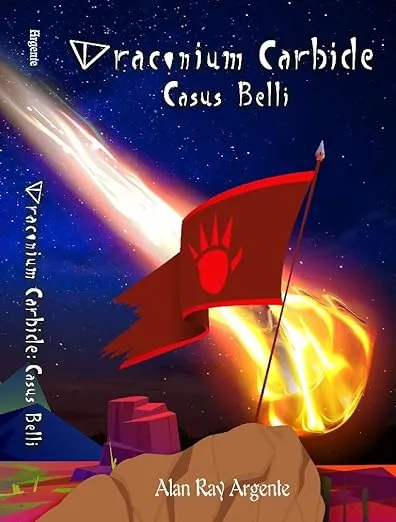Draconium Carbide by Alan Ray Argenle

For countless centuries, dragons have been murdered and robbed in their own lairs with impunity from humans as well as using dragon bones and scales as weapons, armor and trophies. What happens if a certain someone in the past gave the dragonkind an advantage to fight against their human oppressors and desecrators? Know the story from the eyes Karriel and Niaraus just after the war have broken out between the Empire of Ardynia and Blessed Lands of Javyria.
Draconium Carbide by Alan Ray Argenle
I was compensated with a small amount for my time and effort in reading the book and writing this review. However, all thoughts and opinions expressed are my own and are based on my honest personal experience reading the book. Nor did the publisher in any way shape or form ever pressure me to give a positive review.
Draconium Carbide explores a scenario in which dragons, who have been oppressed and killed by humans for their scales and bones, have the opportunity to rebel against their captors. The story follows characters like Karriel and Niaraus as they negotiate the complexity of a world tainted by tyranny and injustice against the backdrop of a conflict between the Empire of Ardynia and the Blessed Lands of Javyria. The narrative delves into issues of justice, repentance, and the right to self-defence, with a cast of different characters that includes the intriguing Niaraus and the captivating Vaidraxus.
Readers are lured into a gripping story that questions their views and makes them consider the complexities of morality and justice as the characters struggle with their past transgressions and moral quandaries. In a world full of violence and injustice, Alan Ray deftly weaves a tale that entertains readers while simultaneously provoking contemplation and thought. He invites them to think about the consequences of their choices and the search for justice.
The narrative format of this novel is interesting because it alternates between Niaraus and Karriel’s first-person points of view, not the usual third-person. Although switching between characters is almost customary in large fantasy novels with large-scale world-building, I was surprised that the characters’ stories were told in their first person. It’s uncommon, in my experience, to come across a first-person fantasy novel with multiple points of view instead of a third-person. So this created a really unique reading experience for me.
Even though I usually enjoy first-person narratives, I had to acclimatize to this change for the reasons mentioned earlier. I was intrigued by this format’s novelty, but I’m not sure how I feel about it all in general. I’m hesitant to judge because I know this is more of a personal preference that can differ between different readers. Therefore to allow each reader to establish their own view regarding this trait, I just wanted to be transparent about this in the review and leave the rest of the judgement to them.
Among the most interesting parts of the narrative, in my opinion, was the examination of Niaraus’s inner conflicts. He gained more depth as a result of exploring his prior traumas and seeing how they affected his moral quandaries, actions, and attitudes. Although I liked how multifaceted he was, I couldn’t help but want more chapters from his point of view. It was surprising to see a clear difference in the number of chapters written by Niaraus and Karriel, especially because Niaraus’s perspective was presented at the beginning of the book. I was taken aback by the story’s sudden shift in emphasis toward Karriel. This decision had an impact on the storyline’s depiction in addition to the tempo.
Because every character has a first-person point of view, the story is especially sensitive to each character’s unique viewpoint. Given this, I think the story would have been better told if Karriel and Niaraus had gotten a more equal share of the chapters. Because of their distinctive roles and divergent personalities, each character presents a unique point of view. Thus, a deeper examination of the main ideas and tensions in the story may have been possible with a more fair representation of their points of view.
Though categorized as fantasy, the political events and concepts that this book weaves in are so poignant that it goes beyond simple escape. Even with mythical aspects like dragons, the story feels surprisingly grounded in reality. Its capacity to reflect contemporary problems and elicit comparisons between the fictitious world and our own is what distinguishes it. It is obvious that the author wants readers to think about the story’s deeper meaning in addition to being engrossed in an interesting narrative.
This piece of writing is a shining example of literature that offers insightful commentary on human nature and societal processes in addition to being enjoyable. The blurring of boundaries between fiction and reality invites readers to consider the intricacies of our global community. Essentially, it’s evidence of the ability of storytelling to elicit contemplation and reflection.
To sum up, Draconium Carbide deviates from the fantasy genre and instead feels more like dystopian sci-fi. Maybe it’s the heavy political topics that run across its pages, or maybe it’s the current technology infused throughout. Interestingly, the existence of dragons continues to be the most imaginative aspect of the story. This comment is not so much a criticism as it is a noteworthy feature that I, as a reader, could not help but notice.
It’s up to you whether or not this departure from typical fantasy appeals to you. But if the idea of a fantasy story with a modern twist and dystopian overtones appeals to you, this book is well worth reading. Its distinctive mash-up of genres presents a novel perspective on the fantasy genre, defying expectations and encouraging readers to delve into previously uncharted territory.
If you liked this review and want to see other book reviews like this one, check out my book reviews collection!


Leave a Reply